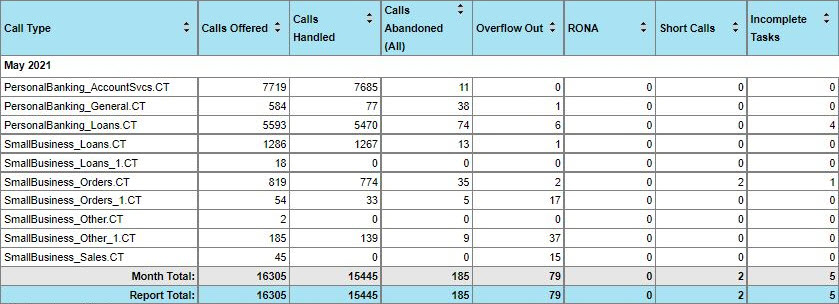Call Offered Outcomes
This report shows the full breakdown of outcomes for calls offered to each call type, including handled, abandoned, RONA, overflow out and other reasons for calls not being handled.
There are versions of this report for each of the historical time intervals, which break down the data by call type & interval. This report uses a Call Type parameter set. It may be found under the following path: Root > Reports > Voice Reports for Cisco > {interval}.

The report is based on the Calls by Call Type model and includes the following columns.
Calls Offered
The number of calls offered to the Call Type during the report interval.
Calls Handled
The number of calls handled by agents during the report interval.
Calls Abandoned (All)
The total number of calls abandoned during the report interval while in VRU, while queued to skill groups at the agent desktop. Note: This column does not include short calls.
Overflow Out
The number of calls that were overflowed to another call type during the report interval.
RONA
Redirected On No Answer – the number of calls that were redirected during the report interval, after they rang at an agent’s phone and the agent failed to answer.
Short Calls
The number of calls answered by an agent during the report interval where the call duration fell short of the Abandoned Call Wait Time, and calls which were routed to non-Agent targets and/or were redirected during the report interval.
Incomplete Tasks
The number of calls that were routed but did not arrive at the Peripheral Gateway during the report interval. Examples of where this may occur include:
- Just as the Call Router is about to send the call to an agent in the Available state, the agent puts themselves in the Not Ready state.
- Just as the Call Router is about to send the call to an agent in the Available state, the agent pushes the head set button or otherwise attempts to make a call from the desk phone.
- Just as the Call Router is about to send the call to an agent in the Available state, the agent is direct dialed.
- The caller disconnects while en-route to the agent.
- Network issues (congestion, glitches, etc.).
Agent Errors
The number of calls that resulted in an error condition while at the agent desktop during the report interval. For example, if the agent suffered from a forced logout, system disconnect or other connection failure that prevented them from handling the call.
Announcements
The number of calls routed with an Announcement node during the reporting period. This node returns a label to the network that specifies the announcement to be played.
Busy
The number of calls that were routed to the Busy target during the report interval.
Calls Routed Non Agent
The number of calls that executed a Label node or a Divert Label node during the report interval. This includes calls that were routed to a standard ACD without using a translation route.
Default Routed
The number of calls where default routing was used during the report interval.
Errors
The number of calls that resulted in an error condition during the report interval (not including Agent Errors which are counted separately). Examples of where this may occur include:
- An appropriate route for the call has not been defined.
- A routing script fails to find a target and there is no default route defined.
- Translation-routed calls are abandoned while en-route to destination target.
- The call has a misconfigured label and does not use default routing.
Network Default Routed
The number of calls that were routed to a Termination node that specifies to use the network default during the reporting interval. This node returns a label to the network that tells it to apply its default treatment to the call.
Release
The number of calls that executed a Release node in their routing script during the reporting interval.
Ring
The number of calls that were routed to the Ring target during the report interval.